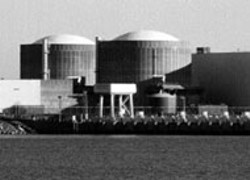Homegrown Hero or Development Monster?
A look at the history of Duke Power/Crescent Resources
By Sam BoykinThings continued to heat up as environmentalists and executives with Rhein and Crescent clashed over the development's environmental safeguards. Developers pointed out they were going above and beyond the county's regulations, while environmentalists said it still wasn't enough to protect the already endangered waters of Lake Wylie and the Catawba River.
Things culminated two weekends ago when the Lower Lake Wylie Association and other environmentalists held a protest march on Buster Boyd Bridge. All signs now indicate the County Commission will vote on the issue December 11. If the commission is unable to reach a decision soon, the entire issue will be turned over to the city when a NC statute allows the City of Charlotte to extend its zoning control to the Catawba River beginning January 1, 2002.
The controversy over The Palisades is hardly the first conflict to arise out of a Crescent development. In fact all along the Catawba River -- at Mountain Island and Lakes James, Norman, Wylie and Wateree -- there have been instances of residents and environmentalists clashing with Crescent and its development interests. (See details in sidebar.) To truly put this issue into
perspective, though, one needs to go back to where it all began -- Duke Power.
According to local historians and information from the company, it was over a century ago when James "Buck" Duke organized The American Development Company to acquire land and water rights on the Catawba River in Chester, Lancaster, and Fairfield counties. In 1900, with the financial backing of Duke, brothers Walker Gill Wylie and Robert H. Wylie incorporated the Catawba Power Company to build the Catawba Hydro Station on the Catawba River at India Hook Shoals near Rock Hill, SC. In 1904 Catawba Power Company's Catawba Hydro Station began operation, powering a nearby textile plant. This was the first generating station in the Duke system and is considered to be the birth of Duke Power Company. Duke and the Wylie brothers later formed the Southern Power Company in 1904 with engineer William States Lee. The Southern Power Company was formed to act as the principal operating company within the expanding system.
As the company grew, Duke and the Wylie brothers created smaller utilities to dam the river and create other power stations. While there is some debate as to the specifics, most historians agree that one of these smaller companies -- the Wateree Power Company -- was given special condemnation authority from the SC legislature in1909. This essentially meant the government gave the smaller utility authority to condemn and seize private property for the sake of the "public good," namely: to create power reservoirs, as well as develop wastewater treatment plants and provide factory jobs. This allowed them to acquire thousands of acres along the Catawba River in South Carolina for relatively cheap prices. By 1925, records indicate the company had condemned and acquired land in North Carolina as well.
While some see this as a seminal period in history that gave birth to a great company, which would provide thousands of jobs and a better way of life for future generations, others don't see it in such glowing terms. Some historians have characterized the formation of Duke Power as big business strong arming rural farmers and forcing them off their land. Moreover, the fact that subdivisions now sit on land that Duke Power originally acquired for the "public good" is considered disingenuous at best by many. (Duke Energy was created in 1996 when Duke Power merged with PanEnergy Corporation. Today, the company has 23,000 employees worldwide, approximately 2 million customers in the Carolinas, and generated revenues of more than $49 billion in 2000.)
Nonetheless, Duke Power continued to grow and prosper, and eventually created "Crescent Land and Timber" in 1969, to which it transferred a majority of the land above the high water mark on the reservoirs. Originally, Crescent Land and Timber was designed to manage and lease land. When Duke Power merged with PanEnergy in 1996 and created Duke Energy, Duke Power then became a subsidiary of Duke Energy, and Crescent became a largely independent sister company of Duke Energy. Today, Crescent Resources acts as a land-management and real estate development company, and has land interests in eight states in the southeastern and southwestern United States. It touts itself as a creator of country club communities, as well as business parks and shopping centers.
However, others see it as a company run amok; a company that takes lands which were originally acquired for the creation and operation of hydropower reservoirs (i.e. the "public good") and turns them into sprawling developments and golf course communities that pollute the Catawba River.
Which brings us back to The Palisades conflict. Crescent stresses that they're going above and beyond the county's environmental requirements. Catawba Riverkeeper Donna Lisenby says that given how this land was originally acquired, it's the least they could do.
"The public utilities were given special permission and power to acquire land from private property owners under the 'public good' justification," Lisenby said. "So the suggestion that they're somehow being generous by going above and beyond the call of duty is ludicrous. There is no doubt that they should be. Regardless of who ultimately develops the land -- Crescent, Rhein, whatever -- the people and the lawmakers of the Carolinas were told the land was going to be used for the purpose of power generation, not subdivision development."
"As to whether or not it's appropriate or legal to develop this land is really hard for me to say," responded Walter Fields, a consultant on the Palisades project. "Typically I've heard that kind of comment in conversations with folks who want to go back to the way it was before we had dams. So I really don't have an opinion on that."
Speaking of Metrobeat.html
-
The Need is Great
Nov 13, 2002 -
Suite Proposition
Oct 23, 2002 -

Lazes Touts Elmwood Area
Oct 9, 2002 - More »
Latest in News
More by Sam Boykin
-

Divine evolution
Nov 11, 2015 -

The Agony & The Ecstasy
Jun 21, 2012 -

'Dynamite' diet with nutritionist Angela Gallo
Jan 18, 2011 - More »
-
ART: Short Fictions by Cara Ober, featuring potter Barbara Chadwick-Bland
Sunday, April 12
-
Dancing The Bard
Hamlet one of three NCDT premiers









